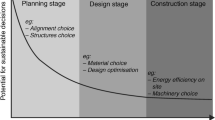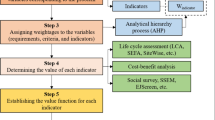Abstract
The American Society of Civil Engineers set three pillars of sustainability, the triple bottom line approach, revolving around the environment, economy and equity. This approach is aligned with the Sustainable Development Goals set by the United Nations. Activities undertaken in any construction project must follow this approach and must be audited to validate their impact on sustainability. Geotechnical projects lack an audit/assessment tool encompassing the triple bottom line. Efforts were made to modify SPeAR (Sustainable Project Appraisal Routine) into Geotechnical SPeAR, but the system lacks the quantification scale as used by Environmental Geotechnics Indicators. The study aims to develop a new tool called Geo-SAT (Geotechnical Sustainability Assessment Tool), overcoming these limitations, incorporating engineering as a vital pillar. Geo-SAT is based on indicators quantified on a scale of 1 (detrimental) to 5 (significantly improved) to assess the impact of actions taken or considered, on sustainability. The total number of indicators developed is 169 out of which 79 are specific to the triple bottom line approach and 90 to engineering. These indicators are generic and can be used for geotechnical projects with the flexibility of exclusion as per the nature of the project. The different fields targeted are dams, foundations, landslides, contaminated site remediation, soil and erosion control, offshore construction and transportation. This tool will serve as a potential code of sustainability for geotechnical projects.











Similar content being viewed by others
Abbreviations
- ASCE:
-
American Society of Civil Engineers
- BREEAM:
-
Building Research Establishment Environmental Assessment Method
- CEEQUAL:
-
Civil Engineering Environmental Quality Assessment and Award Scheme
- DQI:
-
Design Quality Indicator
- EGI:
-
Environmental Geotechnics Indicators
- Geo-SAT:
-
Geotechnical Sustainability Assessment Tool
- LCCA:
-
Life Cycle Cost Analysis
- LEED:
-
Leadership in Energy and Environmental Design
- SD:
-
Sustainable development
- SPeAR:
-
Sustainable Project Appraisal Routine
- UNSDG:
-
United Nations Sustainable Development Goals
References
Arrow, K. J., Dasgupta, P., & Mäler, K.-G. (2003). Evaluating projects and assessing sustainable development in imperfect economies. Environmental & Resource Economics, 26(4), 647–685.
ARUP. (2010). Sustainable building designs strategy. Retrieved August 15, 2019 from https://www.arup.com/expertise/services/buildings/sustainable-buildings-design
ASCE. (2013). Policy statement 418—The role of the civil engineer in sustainable development. Retrieved November 18, 2019 from https://www.asce.org/issues-and-advocacy/public-policy/policy-statement-418---the-role-of-the-civil-engineer-in-sustainable-development/.
Basu, D., Misra, A., & Puppala, A. J. (2015). Sustainability and geotechnical engineering: Perspectives and review. Canadian Geotechnical Journal, 52(1), 96–113.
Biswas, A. K. (1992). Indus water treaty: The negotiating process. Water international, 17(4), 201–209.
Braithwaite, P. (2007). Improving company performance through sustainability assessment. In P. W. Jowitt (Ed.), Proceedings of the institution of civil engineers-engineering sustainability (Vol. 2 and 160, pp. 95–103). London: Thomas Telford Ltd
BRE. (2014). BREEAM UK new construction (1st ed., Vol. 1). Watford: BRE Global Limited.
BRE. (2018). An introduction to CEEQUAL. Watford: BRE Global Limited.
Broere, W. (2016). Urban underground space: Solving the problems of today’s cities. Tunnelling and Underground Space Technology, 55, 245–248.
Brundtland, G. H. (1987). Brundtland report. Our common future. Comissão Mundial: Marseille.
Daly, H. E. (2005). Economics in a full world. Scientific American, 293(3), 100–107.
Gann, D., Salter, A., & Whyte, J. (2003). Design quality indicator as a tool for thinking. Building research & information, 31(5), 318–333.
Harris, C. (2005). Climate change, mountain permafrost degradation and geotechnical hazard. In U. M. Huber, H. K. M. Bugmann, & M. A. Reasoner (Eds.), Global change and mountain regions (1st ed., pp. 215–224). Dordrecht: Springer.
Hellmuth, O. K. A., Transformation, I. f. M., & Services, D. o. C. D. o. R. E. (2008). LEED certifcation guidebook: Process management guidebook for projects in the district of Columbia. In J. Doussard, J. Wotowiec, & K. Aucamp (Eds.), (1st ed., pp. 71). Washington, DC: Government of the District of Columbia Department of Real Estate Services.
Holt, D. G. A. (2010). Sustaibale assessment for geotechnical projects. Birmingham: University of Birmingham.
Horvath, A. (2003). Life-cycle environmental and economic assessment of using recycled materials for asphalt pavements. University of California Transportation Center.
HSE. (2015). Managing health and safety in construction. Construction (Design and Management) Regulations 2015. Guidance on Regulations. The Stationery Office Norwich.
ISI. (2015). Envision rating system for sustainable infrastructure. Washington, DC: ISI and Zofnass Program for Sustainable Infrastructure.
Jefferson, I., Hunt, D. V., Birchall, C. A., & Rogers, C. D. (2007) Sustainability indicators for environmental geotechnics. In P. W. Jowitt (Ed.), Proceedings-Institution of civil engineers engineering sustainability, 2007 (Vol. 160 and 2, pp. 57). Institution of Civil Engineers
Johnston, R. (2016). Arsenic and the 2030 Agenda for Sustainable Development. In Arsenic research and global sustainability: Proceedings of the sixth international congress on arsenic in the environment (As2016), June 19-23, 2016, Stockholm, Sweden (pp. 12). CRC Press.
Kagan, S. (2014). Art and sustainability: Connecting patterns for a culture of complexity (2nd emended edition 2013, Vol. 25). Bielefeld/Wetzlar: Transcript Verlag/Majuskel Medienproduktion GmbH.
Kalair, A. R., Abas, N., Hasan, Q. U., Kalair, E., Kalair, A., & Khan, N. (2019). Water, energy and food nexus of Indus Water Treaty: Water governance. Water-Energy Nexus, 2(1), 10–24.
Khan, M. I., Jamil, S. M., Ali, L., Akhtar, K., & Javaid, M. (2014). Feasibility study of Kalabagh dam Pakistan. Life Science Journal, 11(9s), 458–470.
Kibler, K., Tullos, D., Tilt, B., Wolf, A., Magee, D., Foster-Moore, E., et al. (2012). Integrative Dam Assessment Model (IDAM) documentation: Users Guide to the IDAM methodology and a case study from Southwestern China. Corvallis, OR: Oregon State University.
Kirchherr, J., Ahrenshop, M.-P., & Charles, K. (2019). Resettlement lies: Suggestive evidence from 29 large dam projects. World Development, 114, 208–219.
Kirchherr, J., & Charles, K. J. (2016). The social impacts of dams: A new framework for scholarly analysis. Environmental Impact Assessment Review, 60, 99–114.
Kuriqi, A., Ardiçlioglu, M., & Muceku, Y. (2016). Investigation of seepage effect on river dike’s stability under steady state and transient conditions. Pollack Periodica, 11(2), 87–104.
Lerer, L. B., & Scudder, T. (1999). Health impacts of large dams. Environmental Impact Assessment Review, 19(2), 113–123.
Mazmanian, D. A., & Kraft, M. E. (2009). Toward sustainable communities: Transition and transformations in environmental policy. Cambridge: MIT Press.
McGregor, I., & Roberts, C. (2003). Using the SPeAR TM assessment tool in sustainable master planning. In Proceedings of US Green Building Conference, Pittsburgh, PA, USA. US Green Building Council, Pittsburgh, PA, USA, 2003
Misra, A., & Basu, D. (2011). Sustainability in geotechnical engineering (D. o. C. a. E. Engineering, Trans.). Internal geotechnical report (Vol. 2, pp. 49). University of Connecticut.
Muceku, Y., Korini, O., & Kuriqi, A. (2016). Geotechnical analysis of Hill’s slopes areas in heritage town of Berati. Albania. Periodica Polytechnica Civil Engineering, 60(1), 61–73.
Omoregie, A. I., Siah, J., Pei, B. C. S., Yie, S. P. J., Weissmann, L. S., Enn, T. G., et al. (2018). Integrating biotechnology into geotechnical engineering: A laboratory exercise. Transactions on Science and Technology, 5(2), 76–87.
Peppoloni, S., & Di Capua, G. (2012). Geoethics and geological culture: Awareness, responsibility and challenges. Annals of Geophysics, 3(55), 335–341.
Pham, V. P. (2020). Rice husk ash burnt in simple conditions for soil stabilization. In P. D. Long & N. T. Dung (Eds.), Geotechnics for sustainable infrastructure development (pp. 717–721). New York: Springer.
Praticò, F., Saride, S., & Puppala, A. J. (2011). Comprehensive life-cycle cost analysis for selection of stabilization alternatives for better performance of low-volume roads. Transportation Research Record, 2204(1), 120–129.
Raymond, A. J., Pinkse, M. A., Kendall, A., & DeJong, J. T. (2017). Life-cycle assessment of ground improvement alternatives for the Treasure Island, California, redevelopment. In Geotechnical frontiers 2017 (pp. 345–354).
Scudder, T., & Colson, E. (2019). From welfare to development: A conceptual framework for the analysis of dislocated people. In A. Hansen & A. Oliver-Smith (Eds.), Involuntary migration and resettlement (pp. 267–287). Abingdon: Routledge.
Seager, T., Selinger, E., & Wiek, A. (2012). Sustainable engineering science for resolving wicked problems. Journal of Agricultural and Environmental Ethics, 25(4), 467–484.
Srinivasan, B. (2001). Social impacts of large dams: Gender, equity and distribution issues. Economic and Political Weekly, 36, 4108–4114.
Taha, M. R., & Alsharef, J. M. A. (2018). Performance of soil stabilized with carbon nanomaterials. Chemical Engineering Transactions, 63, 757–762.
Tilt, B., Braun, Y., & He, D. (2009). Social impacts of large dam projects: A comparison of international case studies and implications for best practice. Journal of Environmental Management, 90, S249–S257.
Vanclay, F. (2002). Conceptualising social impacts. Environmental Impact Assessment Review, 22(3), 183–211.
Watson, P., Mitchell, P., & Jones, D. (2004). Environmental assessment for commercial buildings: Stakeholder requirements and tool characteristics. Retrieved June 26, 2019 from https://digitalcollections.qut.edu.au/1661/.
Yasuhara, K., Komine, H., Murakami, S., Chen, G., Mitani, Y., & Duc, D. (2012). Effects of climate change on geo-disasters in coastal zones and their adaptation. Geotextiles and Geomembranes, 30, 24–34.
Author information
Authors and Affiliations
Corresponding author
Ethics declarations
Conflict of interest
The authors declare that they have no conflict of interest.
Additional information
Publisher's Note
Springer Nature remains neutral with regard to jurisdictional claims in published maps and institutional affiliations.
Rights and permissions
About this article
Cite this article
Raza, F., Alshameri, B. & Jamil, S.M. Assessment of triple bottom line of sustainability for geotechnical projects. Environ Dev Sustain 23, 4521–4558 (2021). https://doi.org/10.1007/s10668-020-00786-y
Received:
Accepted:
Published:
Issue Date:
DOI: https://doi.org/10.1007/s10668-020-00786-y




